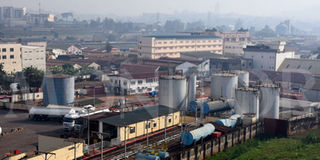Prime
13 fuel depots in city: A ticking time bomb

The Vivo Energy depot on Seventh Street, Industrial Area, Namuwongo in Kampala on February 4. PHOTOS/ISAAC KASAMANI
What you need to know:
- Following a massive explosion at a fuel depot on Seventh Street last week, residents are worried over a reoccurrence of fires due to the high concentration of fuel depots in Kampala.
The fire incident at Vivo Energy Oil terminal in the Industrial Area that injured 12 people last week has ignited a debate of the danger the fuel depots pose in Kampala Metropolitan Area.
Kampala is sandwiched by at least 13 depots that are holding millions of litres of fuel and kilogrammes of highly flammable gases on four of its major routes making the exit for traffic dicey in case of a fire emergency.
In Industrial Area, there are four fuel terminals owned by Vivo Energy and Total. Two fuel depots for Moil and Mogas oil facilities are just a mile away from each other on Jinja Road.
The Mogas’ oil facility is surrounded by a spiralling slum at Banda Township, whose residents use traditional methods of energy and often burn rubbish in the open to save on the garbage collection bills. The facility, which was the most feared, is currently empty as owners struggle to clear debts.
Other petroleum storage facilities are in Wankulukuku, Rubaga Division, Namanve Industrial Area, Mukono District, Kyengera, and Lubigi in Wakiso District.
Most of the neighbours of the fuel facilities have become comfortable around them that they no longer care about the consequences of their activities.
In August last year, local council authorities had to block a resident, who wanted to burn bricks near Vivo Energy facilities on 8th Street in Industrial Area.
The Director of the Police Fire Prevention and Rescue Services, Mr Joseph Mugisa, yesterday said despite the many depots within Kampala Metropolitan Area, chances that they would lead to a disastrous incident are less.
“We have the capacity to handle fire incidents promptly in all those areas. The beauty now is that we (fire fighting teams) are now spread out in the Kampala Metropolitan Area,” Assistant Inspector General of Police Mugisa said.
Mr Mugisa said the fire-fighting trucks are stationed in more than eight areas near the facilities to respond on time in case of fire outbreak.
“We have Kajjansi, Entebbe, Kabalagala, Nansana, Mukono, Butabika and others. For instance, if there is a fire at a facility like in Lubigi, Nansana trucks will respond and will be backed by Kololo fire tenders. We have designed it in that way to handle such fires,” he said.

Mogas depot on Jinja Road, Banda in Kampala on February 4.
Mr Mugisa said his only fears were about the oil facility at Banda, but he said it is empty for now.
He said the oil companies have put in place high standards and increased personnel capacity that have made internal fire response teams effective.
“The companies have enough foam, automatic sprinklers that sense fire and immediately respond to the affected area. We have also trained them to have the capacity to attack fire in case it breaks out,” he said.
Most of the fuel facilities, especially in the city Industrial Area, were established more than 40 years ago as the areas less populated. But urban authority’s weak enforcement policy allowed people to encroach or establish unplanned settlements near the petroleum installations.
The spokesperson of the Ministry of Energy, Mr Solomon Muyita, said the ministry used to determine where the fuel depots are constructed, but the urban authority protested and their powers were transferred to them.
“So the urban authorities determine where the depots will be built. The plan will later be submitted to the National Environment Management Authority for certification that it meets environmental standards.

The Total depot on Eighth Street, Kampala.
The Ministry of Energy issues a construction certificate for the oil storage facility after Uganda National Bureau of Standards has carried out inspection of the quality of the equipment that will be used,” Mr Muyita said.
When the facility has been completed and meets that agreed on standards, the Ministry of Energy will issue a completion certificate and operation licence to the oil company.
Despite the risk of high concentration of terminals of highly flammable products in the urban centre, new ones are being built, especially in districts of Wakiso and Mukono.
Despite the advantages that come with the oil facilities, the deputy spokesperson of Kampala Capital City Authority, Mr Robert Kalumba, said they issued a policy stopping any more establishment of oil facilities in Kampala City.
“It is part of our Smart City campaign to decongest Kampala City. There were many people who applied to KCCA to establish such facilities, but we declined,” Mr Kalumba said.
Mr Kalumba said they understand the danger associated with the oil facilities and they evicted people who were cooking and vending food near facilities that have highly flammable products on the Seventh and Eighth Street, Industrial Area.

People cooking near depots in Banda on February 6, 2022.
Gilbert Otim, the spokesman of Stabex fuel company, whose depot is near the congested Nansana, said yesterday that they used automatic fire detection equipment to ensure that if there is any accident, they respond in time.
“We also have CCTV cameras and watchmen around the facility for surveillance,” Mr Otim said, adding that the first 10 minutes of a fire incident are very important because fire should never be allowed to enter the explosive level, which is so destructive.
laws in place
In 2011, the National Physical Planning Standards and Guidelines that focus on distance that separate petroleum facilities from other structures of different use.
lAccording to the guidelines, a station of liquefied petroleum gas (LPG) must be 55 metres away from a high-rise residential, education or hospital while a commercial, recreational or industrial structure must be 15 metres away.
lLow density residential or incidental dwelling should be 50 metres away from petroleum facilities.




